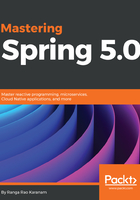
Unit testing with mocks
Let's start with understanding what mocking is. Mocking is creating objects that simulate the behavior of real objects. In the previous example, in the unit test, we would want to simulate the behavior of DataService.
Unlike stubs, mocks can be dynamically created at runtime. We will use the most popular mocking framework, Mockito. To understand more about Mockito, we recommend the Mockito FAQ at https://github.com/mockito/mockito/wiki/FAQ.
We will want to create a mock for DataService. There are multiple approaches to creating mocks with Mockito. Let's use the simplest among them--annotations. We use the @Mock annotation to create a mock for DataService:
@Mock
private DataService dataService;
Once we create the mock, we will need to inject it into the class under test, BusinessServiceImpl. We do that using the @InjectMocks annotation:
@InjectMocks
private BusinessService service =
new BusinessServiceImpl();
In the test method, we will need to stub the mock service to provide the data that we want it to provide. There are multiple approaches. We will use the BDD style methods provided by Mockito to mock the retrieveData method:
BDDMockito.given(dataService.retrieveData(
Matchers.any(User.class)))
.willReturn(Arrays.asList(new Data(10),
new Data(15), new Data(25)));
What we are defining in the preceding code is called stubbing. As with anything with Mockito, this is extremely readable. When the retrieveData method is called on the dataService mock with any object of type User, it returns a list of three items with values specified.
When we use Mockito annotations, we would need to use a specific JUnit runner, that is, MockitoJunitRunner. MockitoJunitRunner helps in keeping the test code clean and provides clear debugging information in case of test failures. MockitoJunitRunner initializes the beans annotated with @Mock annotation and also validates the usage of framework after execution of each test method.
@RunWith(MockitoJUnitRunner.class)
The complete list of the test is as follows. It has one test method:
@RunWith(MockitoJUnitRunner.class)
public class BusinessServiceMockitoTest {
private static final User DUMMY_USER = new User("dummy");
@Mock
private DataService dataService;
@InjectMocks
private BusinessService service =
new BusinessServiceImpl();
@Test
public void testCalculateSum() {
BDDMockito.given(dataService.retrieveData(
Matchers.any(User.class)))
.willReturn(
Arrays.asList(new Data(10),
new Data(15), new Data(25)));
long sum = service.calculateSum(DUMMY_USER);
assertEquals(10 + 15 + 25, sum);
}
}